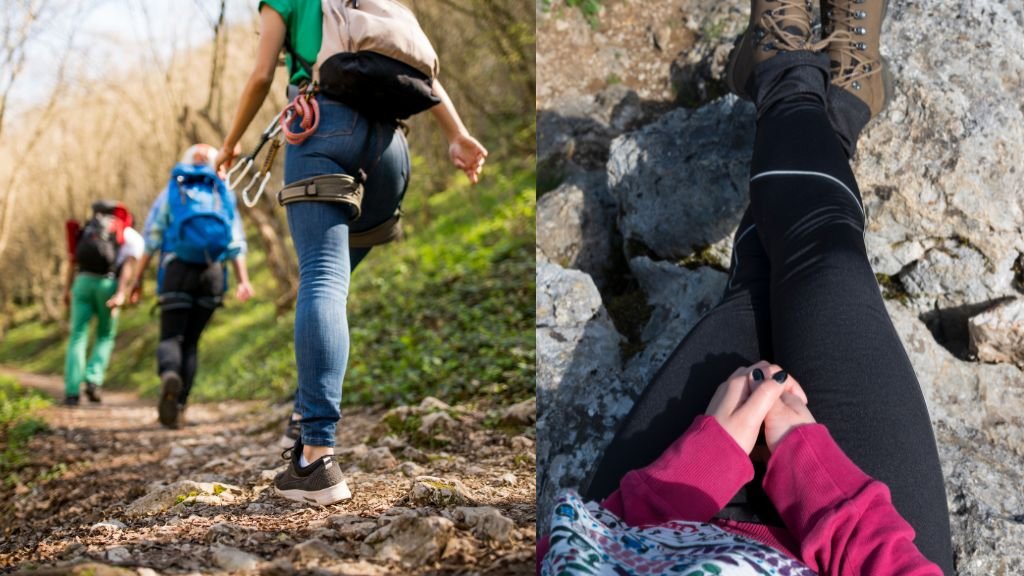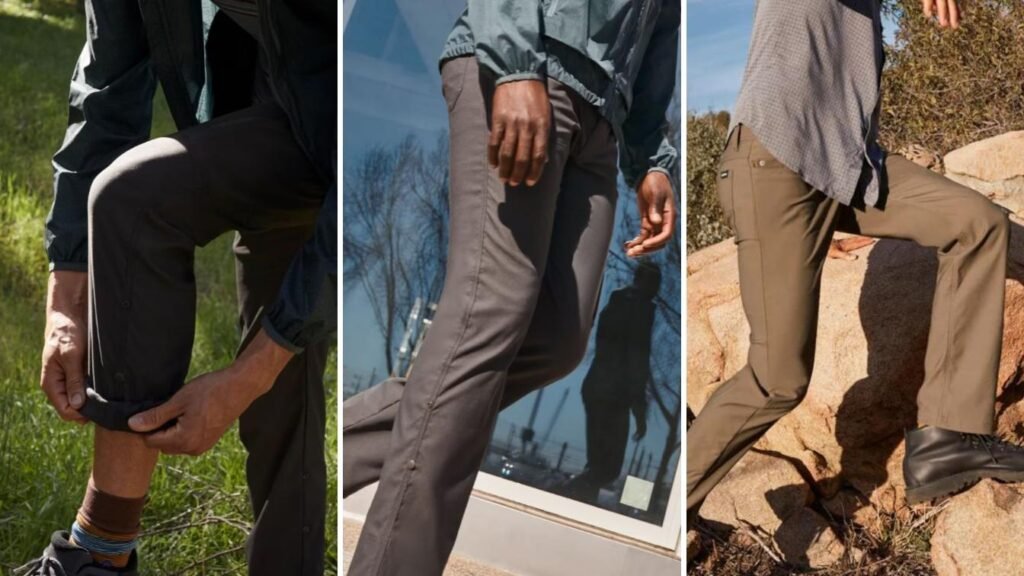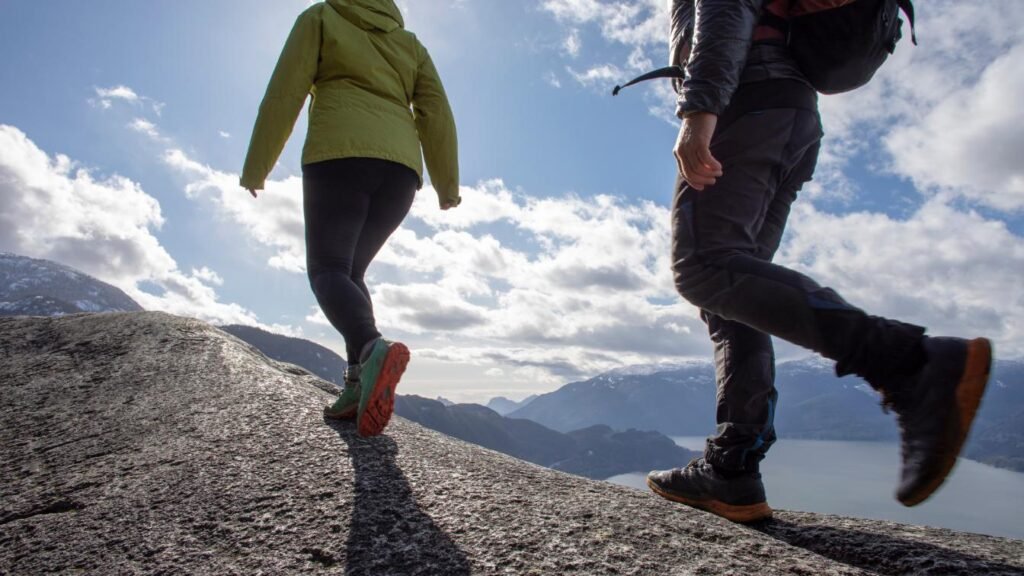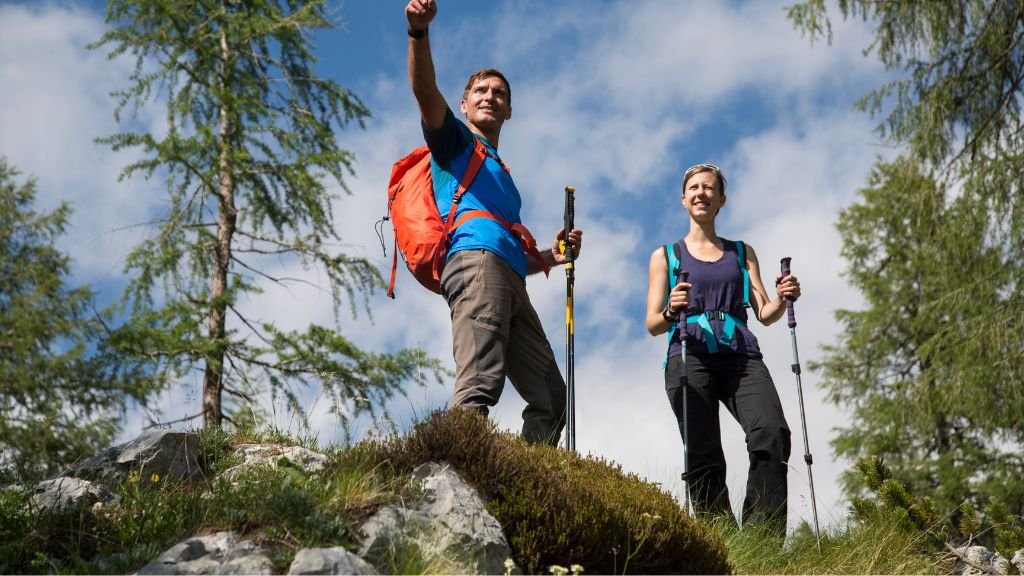When you lace up your hiking boots and head for the trails, the last thing you want is your choice of pants turning into regret.
Making an informed decision on this seemingly minor detail can have a major impact on your comfort and mobility as you conquer peaks and valleys.
This article cuts through the noise to examine the real-world pros and cons of hiking in jeans versus leggings.
Is It Better to Hike in Jeans or Leggings?
Leggings are generally better for hiking than jeans because they offer more flexibility, comfort, and moisture-wicking properties which are essential for a good hiking experience.
Jeans, while durable, have significant downsides for hikers. During long treks, the thick seams and poor accommodation for repetitive leg motion can cause discomfort and even chafing.
The best types of leggings for hiking are yoga pants or athletic leggings as they provide less restriction compared to casual leggings, which can be softer and thinner but not suited for varied terrains.
Jeans and Leggings for Hiking: Factors to Consider
Comfort and Mobility
Feel Good, Move Better
- When you hike, your clothes should feel like a second skin, not something you have to fight against.
- Leggings stretch and move with you, making climbing over rocks or stepping over logs a breeze.
- Jeans might feel snug and safe, but they can limit how well you can move. On a steep trail, that’s a big deal.
Stay Snug or Loose?
- Some people love the tight fit of leggings; they give a sense of support.
- Others want a loose fit. If that’s you, special hiking pants – not jeans – might be your best option.
Weather and Environmental Factors
Hot or Cold, Dry or Wet:
- Sunny and warm? Leggings keep you cooler and dry off faster if you sweat or cross streams.
- On cold days, jeans can feel chilly, and if they get wet, they stay wet. Not fun.
Wind and Wilderness:
- Windy conditions? Leggings might feel too thin. Jeans block wind better but watch out for the chill if they get damp.
- Walking through thick brush or sitting on rough rocks? Jeans offer more protection, but a tough pair of hiking leggings can do the trick, too.
Durability and Protection
Lasting Through Trails:
- Jeans are tough. They can take a lot of scrapes from rocks or thorns.
- However, high-quality leggings are strong, too, and they often come with reinforced areas just where hikers need them.
Guarding Your Legs:
- Think about bugs, sun, and plants. Both jeans and leggings cover your legs, which helps keep you safe.
- Some leggings even have built-in bug repellent or UV protection. Jeans don’t do that.
Jeans vs. Leggings for Hiking: Comparison Table
| Factor | Jeans | Leggings |
|---|---|---|
| Comfort | Restrictive: Can be tight and limit movement. | High Comfort: Stretchy material allows for greater freedom of movement. |
| Mobility | Limited: Stiff fabric makes high-stepping or climbing more difficult. | Excellent Mobility: Provides flexibility for all types of movements on the trail. |
| Moisture Management | Poor: Absorb sweat and stay wet, taking long to dry. | Superior: Designed to wick moisture away from the skin, keeping you dry and comfortable. |
| Adaptability to Weather | Varies: Thick material can be hot in summer, cold when wet, and blocks wind | Versatile: Can be layered for warmth or worn alone; often with UV and insect protection. |
| Durability | Good: Durable but can feel heavy and uncomfortable. | Variable: Some are reinforced for durability without sacrificing comfort or mobility. |
| Protection | Better Protection: Thicker material offers some defense against abrasions and plants. | Some Protection: Though thinner, quality hiking leggings can offer similar protection. |
| Drying Time | Longer: Takes much longer to dry once wet, which can be problematic on long trails. | Quick Dry: Fast-drying fabrics mean less discomfort if you get wet. |
From the comparison, it’s clear that while jeans do offer certain protective qualities, leggings outperform them in comfort, mobility, moisture management, adaptability, and drying time making them a preferable choice for most hiking situations.
Hiking in Jeans: Pros & Cons
When preparing for a hike, you might wonder if jeans are a good choice to wear. Let’s look at some simple facts about hiking in jeans to help you decide.
The Good Stuff about Hiking in Jeans
Tough Like the Trail:
- Jeans are strong. They’re made from denim, which can take a lot of wear and tear.
- If you walk through rough spots with sharp rocks or branches, jeans can help protect your legs from cuts and scratches.
Stay Warm and Safe:
- Thick denim is great for blocking the wind. This can keep you warm on breezy days.
- When you walk through tall grass or woods, jeans can shield you from thorny bushes and insect bites.
The Not-So-Great Things about Jeans on the Trail
Staying Dry is Hard:
- Jeans like to hold onto water. If they get wet from rain or crossing streams, they stay damp.
- Wet jeans are uncomfortable. In cold weather, this can even be dangerous because it makes it hard for your body to stay warm.
Move Free? Maybe Not:
- Denim isn’t very stretchy. This means jeans can stop you from moving as freely as you might like.
- Climbing over logs or up steep hills could be tougher in jeans because they don’t give you the same range of motion as other pants.
Heavy and Slow to Dry:
- Jeans can feel heavy, especially if they get wet.
- Once they soak up water, drying out takes a long time. This means you might have to wear wet jeans for the rest of your hike, and nobody likes that.
Best Practices for Hiking in Jeans
Despite the cons, if you prefer to hike in jeans, consider these tips to make the most of it:
- Choose Wisely: If you want to wear jeans, pick a pair that’s a bit loose for better movement.
- Layer Up: Wear thermal leggings underneath your jeans in cold weather to keep warm if the jeans get wet.
- Be Prepared: Always check the weather before you go. If rain is on the way, jeans might not be the best pick.
- Pack Smart: Bring an extra pair of pants, just in case your jeans get too wet or uncomfortable.
Remember, where you hike matters too. On a dry, cool day in the canyons of Utah, jeans could work well. But if you’re planning to trek through the rainy forests of the Pacific Northwest, you might think twice and choose something built for wet conditions.
Hiking in Leggings: Pros & Cons
Let’s look at the good parts and the not-so-good parts of picking leggings for your next outdoor adventure.
The Bright Side of Wearing Leggings on Hikes
Ease and Stretch:
- Leggings are light and comfortable. This makes moving around easy.
- When you wear leggings, you can bend, stretch, and climb without feeling held back.
Stay Dry, Feel Good:
- A lot of leggings pull sweat away from your skin. This keeps you dry.
- Being dry means you’re less likely to get cold or have skin problems from rubbing.
Dries Quickly:
- If your leggings get wet, they won’t stay wet for long.
- Fast drying means you won’t be hiking with wet pants, which is a plus.
The Other Side: What’s Not Great About Hiking in Leggings
Not as Tough as Jeans:
- Leggings may not be the best against sharp rocks or sticks. They could tear more easily than jeans.
- Heavy bushes or rough paths could cause problems for thin leggings.
Won’t Keep You as Warm:
- Leggings are often made from thin material. In cold weather, this might not keep you very warm.
- When it’s windy or the temperature drops, jeans might protect you better.
Where Do You Put Your Stuff?:
- Many leggings come without pockets. This makes it hard to carry things like a map, snacks, or your phone.
- If they do have pockets, they might be small and not hold much.
How to Make the Best of Leggings for Hiking
If you decide to hike in leggings, here are some helpful pieces of advice:
- Pick the Right Pair: Look for leggings that are thick and have a reinforced knee area for extra protection.
- Layering: On cold days, wear thermal layers under your leggings or choose fleece-lined ones.
- Weather Watch: Always check the forecast. If it might rain or snow, make sure your leggings can handle it or pack a waterproof layer.
- Carry an Extra: It’s smart to have an additional pair of leggings or other pants on hand in case the ones you’re wearing get damaged or too wet.
Leggings might be just right for a calm walk in a clean park. But if you’re heading into wild areas with lots of brush or rocky terrain, you may need something sturdier.
Making the Right Choice for Your Hike
Will it be jeans or leggings? Your choice can change how you feel on the trail. Here’s how to choose well for a great time outdoors.
Look at the Land
Before you pick your pants, think about where you will walk. If the path is smooth and easy, like in a local park, you have more freedom to choose. But if it’s a tough trail with sharp rocks, high grass, or unfriendly plants, you need to think hard about what will work best.
Choosing for Rough Ground:
- Jeans are tough. They might save your legs from scratches and cuts.
- Thick leggings can also work. Just make sure they’re made to last through rough spots.
Keep an Eye on the Weather
The sky above decides a lot about what you should wear below. Look up the weather before you go. Will it rain, or is it going to be cold? The answer tells you what’s best to wear.
Picking for Wet or Cold Days:
- Jeans can feel very heavy when wet, and they take a long time to dry.
- Leggings often handle water better and dry faster. They can also fit under rain pants if needed.
In cold weather, jeans can block wind better than thin leggings. But if you wear warm layers under leggings, you can still stay cozy.
What Makes You Feel Good?
At the end of the day, you should wear what makes you happy and comfortable. Some people love how leggings let them move. Others find jeans more comfy and safe. Think about what you like. Then, go with that.
Questions to Ask Yourself:
- Do I feel good walking in these for hours?
- Do they let me move freely?
- Will I stay warm enough?
Conclusion
Whether you choose jeans or leggings depends on your trail, the weather, and how you like to hike.
If you hike in a place with lots of rough spots and sharp things, jeans might be your friend. They protect you from scratches.
For wet or very chilly days, leggings might do better. They stay light when wet and fit under other clothes for warmth.
My advice is to try both jeans and leggings in places close to home. See how each pair works for you. After some trial runs, you’ll know what suits your style when you hit the trails for real.

Martha Heller
Hey there! I’m Martha, the face behind BigfootHiking.com – a blog I created alongside my husband Lukas. Originally from Phoenix, I’ve made hiking my life’s passion. With over 100 hikes under my belt in the past 7 years, and still counting, I’m always on the move. One of my proudest achievements was conquering Angel’s Landing in Zion National Park. When I’m not on the trails, you’ll find me tinkling on the piano or lost in my drawings. Drop by our blog for tips, tales, and plenty of trail inspiration!





